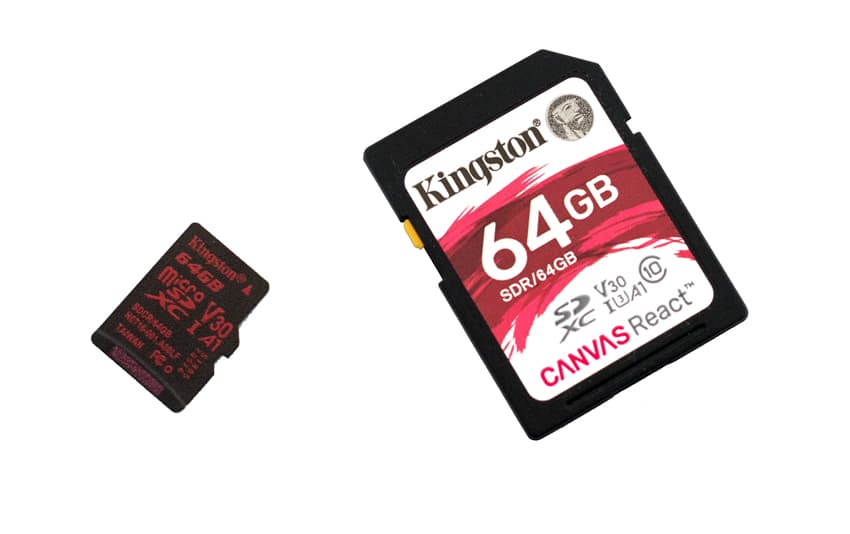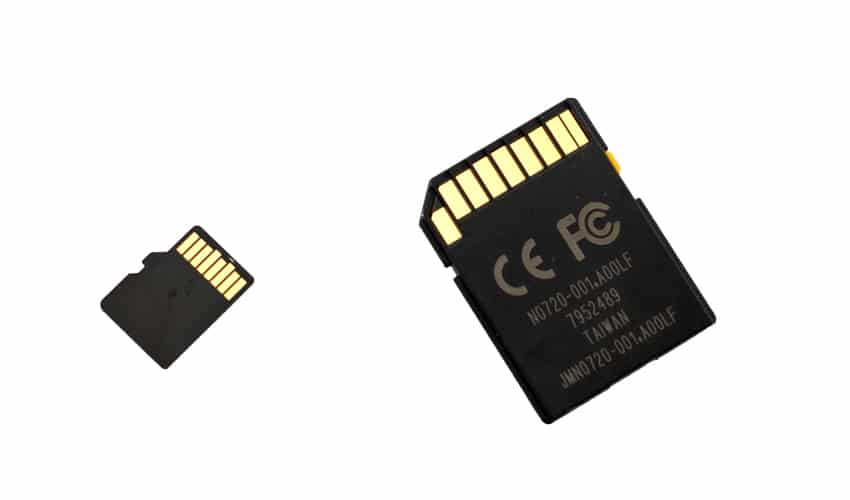Professional photographers need very fast storage cards, and that’s what the new Kingston Canvas React SD and microSD cards promise. No matter the size, they offer up to 100MBps read and 80MBps write. The cards support Class 10 UHS-1 U3, so they’re fast enough to record 4K video, as well as burst-mode photography.

Another requirement for pro photographers is plenty of storage space. The full-size version of this removable card is available with up to 256GB of capacity. There are also less expensive 128GB, 64GB, and 32GB versions. The microSD version tops out at 128GB of capacity, and there are 64GB and 32GB options.
Kingston promises the Canvas React line is durable. All the cards are waterproof, capable of surviving up to 30 minutes submerged in a meter of water. They won’t be damaged by temperatures as low as -13 degrees (-25º C) or as hot as 185 degrees (85º C). Even more importantly, they won’t be damaged or erased by airport X-rays.
Kingston Canvas React SD and microSD Card Specifications
| Capacities | 16GB | 32GB | 64GB | 128GB | 256GB (SD only) |
| Performance | 100MB/s read and 80MB/s write (70MB/s for 32GB), UHS-I Speed | ||||
| Class | 1 (U1) | ||||
| Dimensions | SD: 24mm x 32mm x 2.1mm MicroSD:11mm x 15mm x 1mm | ||||
| Format | FAT32 (SDHC 32GB) | exFAT (SDXC 64GB-128GB) | |||
| Temperature | |||||
| Operating | -25°C to 85°C | ||||
| Storage | -40°C to 85°C | ||||
| Voltage | 3.3V | ||||
| Warranty | Lifetime | ||||
Design and Build
The form factor for both versions of the Kingston Canvas React are completely controlled by their respective formats. An SD card has to fit into an SD slot. The same holds true for all microSD cards. That makes the SD card 0.94 by 1.26 by 0.083 inches (24 x 32 x 2.1 mm). In colloquial terms, it’s about the size of a postage stamp. The microSD card is 0.43 by 0.59 by 0.039 inches (11mm x 15mm x 1mm). That makes it about as big as a pinkie nail.

No matter the size, the front of both Canvas React versions have the Kingston name, the capacity of the card, and some details on the data transfer speeds it offers. On the left side of the SD card is a small switch that prevents the contents from being erased inadvertently. The microSD version is much too small for one of these. On the back of each are the standard metal contacts required for their formats.
Performance
In this review, we will compare the new Kingston Canvas React SD and microSD cards to the following:
These cards debuted together, with the React promising higher speeds for additional cost. Both our test units are 64GB versions of the Canvas React, and used our HP Z2 mini Workstation for testing.
We started with the SD model. The React’s 2MB sequential read speed turned out to be 46.5MB/s and its 2MB sequential write speed is 39.2MB/s. The Canvas Go! card we used for comparison offered 46.0MB/s read and 42.6MB/s write. The Canvas Select SD card, on the other hand, offered considerably slower performance, with 26.7MB/s read and 7.6MB/s write. In the 2MB random speed test, the Canvas React offered 36.2MB/s read and 24.3MB/s write. The slightly cheaper Canvas Go! had 40.0MB/s read and 1.3MB/s write. The Canvas Select came in at 24.5MB/s read and 0.7MB/s write, as one would expect with the cheapest model.
For 4K random IOPS transfers, the Canvas React SD card had 1,657 IOPS reading and 1,366 IOPS writing. The Canvas Go! card’s score was 2,110 IOPS reading and 169 IOPS writing. The Canvas Select posted 1,175 IOPS and 18 IOPS in read and write, respectively. The React had a huge advantage in write speeds on this particular test.
Next, we moved to the microSD model, and again compared it to the microSD versions of the Canvas Go! and Canvas Select. In most cases, the benchmark results for the small and large cards were quite similar. We found the Canvas React’s score on the 2MB sequential read speed to be 46.6MB/s and the equivalent write speed to be 39.5MB/s. The Canvas Go! gave us 46.0MB/s read and 42.8MB/s write. An equally-sized Canvas Select card had 28.3MB/s read and 6.6MB/s write. In the 2MB random speed test, the Canvas React had 36.2MB/s read and 24.4MB/s write speeds. The Canvas Go! had 36.0MB/s read and 1.3MB/s write. The microSD version of the Canvas Select offered 26.1MB/s read and 1.0MB/s write.
And then there’s the benchmark for 4K random IOPS transfers. The microSD React card scored 1,649 IOPS reading and 1,361 IOPS writing. The Canvas Go! card score was 2,255 IOPS and 97 IOPS in read and write, respectively. The Canvas Select posted 1,657 IOPS reading and 103 IOPS writing.
Conclusion
Professionals need quick storage cards, and that’s what the Canvas React offers, though our real-world benchmark tests showed it doesn’t live up to Kingston’s speed promises. The card also didn’t always outperform two of this manufacturer’s less expensive cards. But a closer look at the data turns up an important point: for photography, saving images and video is more important than displaying them, and the Canvas React almost always outperformed the Canvas Select and Go! in this area.
Take the 2MB random speed test as an example. The React saved data at 24.3MB/s, the Go! at 1.3MB/s, and the Select at 0.7MB/s. This huge advantage was also present in the microSD version of this test. That goes a long way in justifying the relatively slight additional cost. To compare apples-to-apples, the 128GB Canvas React retails at $72.80, while equivalently sized Go! and Select cards are $68.60 and $55.25, respectively.
The Bottom Line
The Kingston Canvas React SD and microSD Cards offer quick enough performance to suit most professional photographers, whether photo or video. And the price is reasonable for what they offer.



 Amazon
Amazon